DECEMBER KEY FIGURES
 |  | Dec 04 | Nov 04 to Dec 04 | Dec 03 to Dec 04 |  |
 |  | '000 | % change | % change |  |
|  |
| Short-term visitor arrivals |  |  |  |  |
 | Trend | 448.6 | 0.5 | 5.0 |  |
 | Seasonally adjusted | 452.2 | -0.5 | . . |  |
 | Original | 593.1 | . . | . . |  |
| Short-term resident departures |  |  |  |  |
 | Trend | 391.8 | 1.8 | 17.1 |  |
 | Seasonally adjusted | 406.9 | 5.4 | . . |  |
 | Original | 509.1 | . . | . . |  |
|  |
| . . not applicable |
Visitor arrivals, Short-term
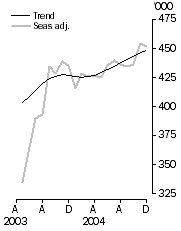
| Resident departures, Short-term
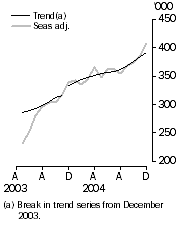
|
DECEMBER KEY POINTS
TREND ESTIMATES
- The trend estimate for short-term visitor arrivals to Australia during December 2004 (448,600 movements) increased by 0.5% compared with November 2004. This followed monthly increases of 0.7% each for October and November 2004.
- Currently, short-term visitor arrivals are 5.0% higher than in December 2003 and 5.5% higher than when the series last troughed in February 2004 (425,300 movements).
- During December 2004, short-term resident departures (391,800 movements) increased by 1.8% compared with the previous month and followed increases of 2.1% for October and 2.2% for November 2004.
- Short-term resident departures have recorded continued growth over the past year. Compared with December 2003 (334,500 movements), short-term resident departures are up by 17.1% and up by 37.4% from when they last troughed in April 2003 (285,200 movements). These increases were affected by a break in the trend series.
SEASONALLY ADJUSTED ESTIMATES
- The seasonally adjusted estimate for short-term visitor arrivals during December 2004 (452,200 movements) decreased by 0.5% compared with November 2004. Short-term visitor arrivals increased by 0.4% for October and 4.1% for November 2004.
- Short-term resident departures for December 2004 (406,900 movements) increased by 5.4% compared with November 2004 and followed increases of 1.7% for October and 3.1% for November 2004.
ORIGINAL ESTIMATES
- In original movement terms, there were 593,100 short-term visitor arrivals to Australia and 509,100 short-term resident departures from Australia during December 2004.
NOTES
EARLY ESTIMATES
Early estimates of short-term visitor arrivals for January 2005 will be available on the Australian Bureau of Statistics (ABS) web site on 18 February 2005. These estimates can be accessed by going to the AusStats web page <https://www.abs.gov.au/ausstats> and selecting Publications & Data and then Main Features. Select 34 Migration and then select Short-term Visitor Arrival Estimates, Australia (cat. no. 3401.0.55.001).
DATA NOTES
This publication contains movement data. Care should be taken when interpreting this movement data as 'people'. See paragraph 5 of the Explanatory Notes for more detail.
Calculations of percentage and numeric change are based on unrounded data. See paragraph 12 of the Explanatory Notes for more detail.
CHANGES IN THIS ISSUE
There are no changes in this issue.
FORTHCOMING CHANGES
New standard errors
A new set of standard errors will apply to sampled estimates in this publication from the January 2005 issue. This is because the sample for short-term movements has been increased as a result of a review, resulting in smaller standard errors. New standard errors will be presented in the Standard Errors section from the January 2005 issue.
EMERGING ISSUES
December 2004 Indian Ocean tsunami
The 26 December 2004 Indian Ocean earthquake and tsunami may impact on overseas visitor arrivals from, and resident departures to, affected countries. However, it is not possible as yet to gauge the magnitude of this impact or its duration. There may also be breaks in some trend series as a result of this event.
INQUIRIES
For further information about these and related statistics, contact the National Information and Referral Service on 1300 135 070 or Anne Ward on Canberra (02) 6252 6871.
MAIN FEATURES
SHORT-TERM VISITOR ARRIVALS
In trend terms, short-term visitor arrivals to Australia in December 2004 have increased by 5.0% when compared with December 2003. Monthly increases have been recorded since March 2004 with visitor arrivals increasing from 425,600 movements in March to 448,600 movements in December 2004.
The following table presents the top ten source countries (based on original estimates) for short-term visitor arrivals during December 2004. Seasonally adjusted and trend estimates are also presented for these countries, along with the trend percentage change compared with November 2004 and December 2003.
Short-term Visitor Arrivals, Major Source Countries - December 2004 |
|  |
 | Trend | Seasonally Adjusted | Original | Nov 04 to Dec 04 | Dec 03 to Dec 04 |  |
 | '000 | '000 | '000 | Trend % change | Trend % change |  |
|  |
| United Kingdom | 54.7 | 57.3 | 109.2 | -0.5 | -4.5 |  |
| New Zealand | 87.9 | 89.2 | 97.7 | -0.1 | 14.1 |  |
| Japan | 63.5 | 58.4 | 62.5 | 0.6 | 2.3 |  |
| United States of America | 35.3 | 37.4 | 44.1 | -0.3 | -0.1 |  |
| Singapore | 22.3 | 21.4 | 36.0 | 1.9 | 3.3 |  |
| China | 24.2 | (a)np | 25.1 | 2.8 | 20.8 |  |
| Korea | 18.3 | 17.4 | 19.4 | - | 2.7 |  |
| Malaysia | 15.2 | 14.9 | 18.8 | -1.0 | 1.5 |  |
| Hong Kong | 12.5 | 12.8 | 16.4 | 1.9 | 12.3 |  |
| Germany | 12.1 | 12.5 | 15.4 | 0.4 | 4.3 |  |
|  |
| - nil or rounded to zero (including null cells) |
| (a) Seasonally adjusted data for short-term visitor arrivals from China is of an unpublishable standard. |
SHORT-TERM RESIDENT DEPARTURES
In trend terms, short-term resident departures have increased by 17.1% between December 2003 and December 2004 and have recorded consecutive monthly increases during the period. However, this increase was affected by a break in the trend series in December 2003. See paragraph 22 of the Explanatory Notes linked to this Main Features.
The following table presents the top ten destinations (based on original estimates), for short-term resident departures during December 2004. Seasonally adjusted and trend estimates are also presented for these countries, along with the trend percentage change compared with November 2004 and December 2003.
Short-term Resident Departures, Major Destinations - December 2004 |
|  |
 | Trend | Seasonally Adjusted | Original | Nov 04 to Dec 04 | Dec 03 to Dec 04 |  |
 | '000 | '000 | '000 | Trend % change | Trend % change |  |
|  |
| New Zealand | 70.1 | 74.2 | 116.6 | -0.1 | 12.5 |  |
| United States of America | 32.2 | 33.1 | 41.5 | 1.1 | 17.9 |  |
| United Kingdom | 31.8 | 32.1 | 33.6 | 0.8 | 9.7 |  |
| Indonesia | 29.6 | 32.6 | 28.2 | 4.9 | (a)np |  |
| Hong Kong | 14.8 | 14.6 | 21.9 | 3.5 | 25.2 |  |
| China | 17.0 | 16.5 | 20.6 | 0.5 | 38.1 |  |
| Thailand | 18.0 | 18.7 | 19.7 | 3.8 | 23.8 |  |
| Fiji | 16.9 | 16.7 | 18.8 | 3.5 | 29.5 |  |
| Viet Nam | 10.2 | 10.3 | 18.7 | 0.7 | 35.4 |  |
| Singapore | 15.9 | 17.4 | 18.5 | 5.1 | 28.2 |  |
|  |
| (a) Not available for publication, due to break in the trend series from December 2003. See paragraph 22 of the Explanatory Notes. |
SHORT-TERM TRAVEL - THE YEAR 2004
Short-term visitor arrivals
In original terms there were 5.2 million short-term visitor arrivals in Australia in the year ended December 2004. This is the highest number of arrivals ever recorded for a calendar year. In the calendar year 2003 there were 4.7 million visitor arrivals.
The top source countries for short-term visitor arrivals during 2004 were New Zealand (20%), Japan (14%), the United Kingdom (13%), the United States of America (8%) and Singapore and China (each 5%).
Just over half of all short-term visitors to Australia in 2004 stated the main reason for journey as holiday (51%) followed by visiting friends and relatives (20%) and business (9%).
Short-term resident departures
In original terms there were 4.4 million short-term resident departures from Australia in the year ended December 2004. As with visitor arrivals, this is the highest number of resident departures ever recorded for a calendar year. In the calendar year 2003 there were 3.4 million resident departures.
The top destinations for Australian residents departing short-term during 2004 were New Zealand (19%), the United States of America and the United Kingdom (each 9%), Indonesia (8%) and Thailand (4%).
Just under half of all short-term residents departing Australia in 2004 stated the main reason for travel as holiday (47%) followed by visiting friends and relatives (25%) and business (15%).
PERMANENT AND LONG-TERM MOVEMENTS
There were 10,280 permanent (settler) arrivals into Australia during December 2004, an increase of 13.3% when compared with December 2003 (9,080 movements). Settlers born in New Zealand accounted for the largest proportion (15%) followed by the United Kingdom (14%) and China and India (each 7%).
Statistics on overseas arrivals and departures relate to the number of movements of travellers rather than the number of travellers. Therefore, care should be taken when using long-term arrivals data as it is known some individuals who travel multiple times in a year are counted each time they cross Australia's borders (see paragraph 5 of the Explanatory Notes linked to this Main Features). Long-term arrivals in this publication are not an appropriate source of migration statistics. For further information refer to Australian Demographic Statistics (cat. no. 3101.0).
There were 6,070 Australian residents departing permanently from Australia during December 2004, an increase of 15% when compared with December 2003 (5,280 movements).
STATISTICAL SIGNIFICANCE
The above presentation of movements in estimates does not take into account whether the change in movement is statistically significant. Care should be taken when interpreting the impact of numeric and/or percentage change. Please see the Standard Errors document linked to this Main Features.
SEASONALLY ADJUSTED AND TREND ESTIMATES
INTRODUCTION
Seasonally adjusted and trend estimates add to the understanding of Overseas Arrivals and Departures (OAD) statistics. Seasonally adjusted estimates allow users to analyse short-term movements including irregular impacts on the series, while trend estimates provide a better method to analyse and monitor the underlying direction of the short-term movement series. In most cases, the trend series is the best source of information on the long-term direction of these statistics.
SHORT-TERM VISITOR ARRIVALS
Selected Source Countries
The graphs presented below illustrate the impact of the 2003 Rugby World Cup on arrivals from the United Kingdom in the latter half of 2003, and the significant impact of Severe Acute Respiratory Syndrome (SARS) on arrivals from Japan.
United Kingdom
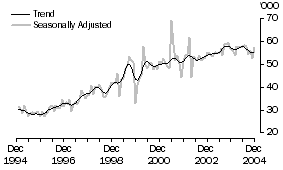 Japan
Japan
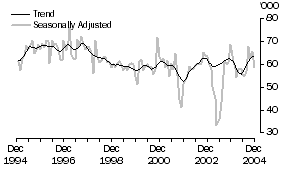
SHORT-TERM RESIDENT DEPARTURES
Selected destinations
For residents departing to the United States of America the graph illustrates the effect that the terrorist attacks in that country, on 11 September 2001, had on short-term departures of Australian residents to the United States of America. The graph for New Zealand illustrates that departures of Australian residents have been trending upwards since May 2003.
United States of America
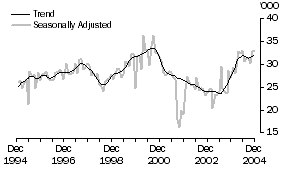 New Zealand
New Zealand
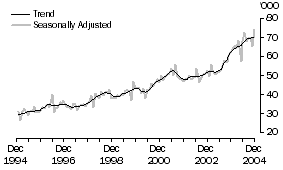
 Print Page
Print Page
 Print All
Print All